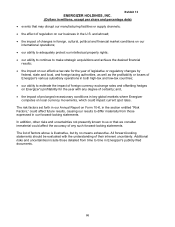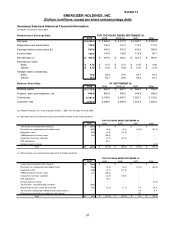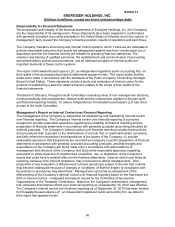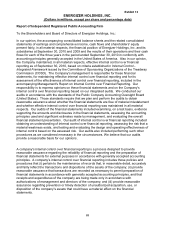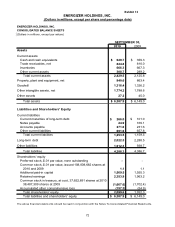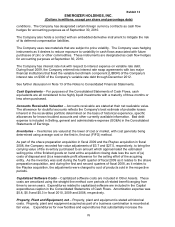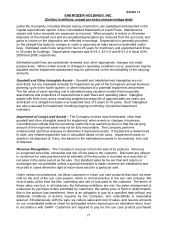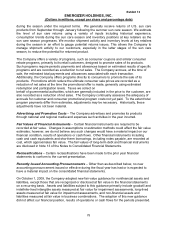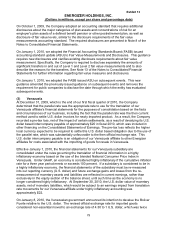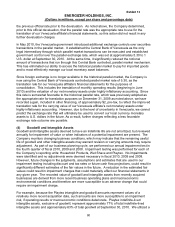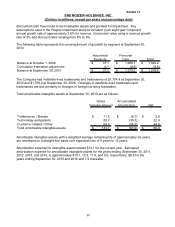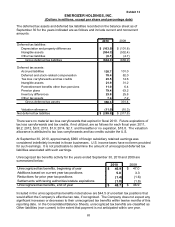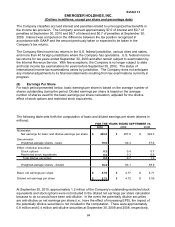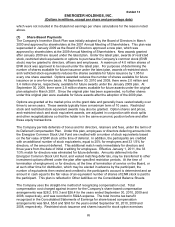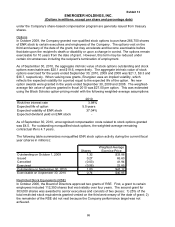Energizer 2010 Annual Report Download - page 86
Download and view the complete annual report
Please find page 86 of the 2010 Energizer annual report below. You can navigate through the pages in the report by either clicking on the pages listed below, or by using the keyword search tool below to find specific information within the annual report.
Exhibit 13
ENERGIZER HOLDINGS, INC.
(Dollars in millions, except per share and percentage data)
76
conditions. The Company has designated certain foreign currency contracts as cash flow
hedges for accounting purposes as of September 30, 2010.
The Company also holds a contract with an embedded derivative instrument to mitigate the risk
of its deferred compensation liabilities.
The Company uses raw materials that are subject to price volatility. The Company uses hedging
instruments as it desires to reduce exposure to variability in cash flows associated with future
purchases of zinc or other commodities. These instruments are designated as cash flow hedges
for accounting purposes at September 30, 2010.
The Company has interest rate risk with respect to interest expense on variable rate debt.
During fiscal 2009, the Company entered into interest rate swap agreements with two major
financial institutions that fixed the variable benchmark component (LIBOR) of the Company’s
interest rate on $300 of the Company’s variable rate debt through December 2012.
See further discussion in Note 13 of the Notes to Consolidated Financial Statements.
Cash Equivalents – For purposes of the Consolidated Statements of Cash Flows, cash
equivalents are all considered to be highly liquid investments with a maturity of three months or
less when purchased.
Accounts Receivable Valuation – Accounts receivable are stated at their net realizable value.
The allowance for doubtful accounts reflects the Company’s best estimate of probable losses
inherent in the receivables portfolio determined on the basis of historical experience, specific
allowances for known troubled accounts and other currently available information. Bad debt
expense is included in Selling, general and administrative expense (SG&A) in the Consolidated
Statements of Earnings.
Inventories – Inventories are valued at the lower of cost or market, with cost generally being
determined using average cost or the first-in, first-out (FIFO) method.
As part of the shave preparation acquisition in fiscal 2009 and the Playtex acquisition in fiscal
2008, the Company recorded fair value adjustments of $3.7 and $27.5, respectively, to bring the
carrying value of the inventory purchased to an amount which approximated the estimated
selling price of the finished goods on hand at the acquisition closing date less the sum of (a)
costs of disposal and (b) a reasonable profit allowance for the selling effort of the acquiring
entity. As the inventory was sold during the fourth quarter of fiscal 2009 as it relates to the shave
preparation acquisition, and during the first and second quarters of fiscal 2008, as it relates to
the Playtex acquisition, the adjustments were charged to cost of products sold in the respective
periods.
Capitalized Software Costs – Capitalized software costs are included in Other Assets. These
costs are amortized using the straight-line method over periods of related benefit ranging from
three to seven years. Expenditures related to capitalized software are included in the Capital
expenditures caption in the Consolidated Statements of Cash Flows. Amortization expense was
$5.8, $5.9 and $5.3 in fiscal 2010, 2009 and 2008, respectively.
Property, Plant and Equipment, net – Property, plant and equipment is stated at historical
costs. Property, plant and equipment acquired as part of a business combination is recorded at
fair value. Expenditures for new facilities and expenditures that substantially increase the


